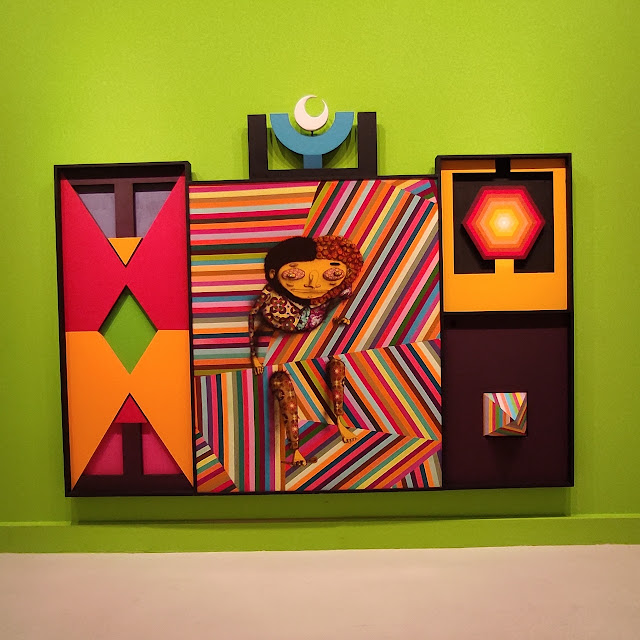OSGEMEOS brings Brazilian street art aesthetics to the museum
The last time I had seen work by OSGEMEOS was at Frieze London 2018 so I was rather looking forward to viewing When the leaves turn to yellow, the collaborative art duo´s debut European museum exhibition at CAC Malaga.
Although today OSGEMEOS, made up of Brazilian identical twins Otávio and Gustavo Pandolfo (Sao Paulo, 1974), is also internationally known for vibrant gallery work, it continues to merge street culture with Brazilian verve and folklore. The duo´s work depicts ambiguous, cartoonish yellow figures and embraces the fantastical in a dreamlike manner.
More than 20 pieces created between 2006-2022 by OSGEMEOS (Portuguese for ¨the twins¨) adorn the Contemporary Art Centre´s walls. They are mainly framed paintings, but also a mural, and an audio installation comprising anthropomorphic boxes quietly playing hip hop tunes from speakers in their mouths. An LCD screen displaying a slideshow of the duo´s earlier street art, as well as a wall covered in drawings, complete the scene.
 |
| One World, One Voice, 2022. Audio installation, 40 parts, dimensions variable. |
 |
| When the leaves turn to yellow installation view, CAC Malaga, 2022 |
Colour envelopes the viewer upon entering the exhibition hall. Not only are the OSGEMEOS paintings vibrant, but they also exude joy, serenity and even quiet discomfort. The walls also come to life, with shades of yellow, blue, green, pink and red, adding to the visitor´s overstimulated sense of sight. The figures´ stylised bodies and mainly yellow faces share a fantastical, floating, and often surreal quality whether they find themselves trapped in aquarium-like glass bottles alongside sea life, as a fisherman with a mermaid on a boat or as someone appearing to melt away in the hot summer sky. The cartoonish figures also echo The Simpsons characters, if only for their amber tones.
 |
| Aquarium, 2019. Acrylic and spray paint on MDF board. 204 x 164 cm |
The show´s titular work, When the leaves turn to yellow, depicts a woman with hands together and feet dangling below as she sits on a narrow window ledge. A heart partly submerged in clear liquid is inside a glass capsule on her chest as she blankly stares at the audience. Is she relaxing? Is she waiting for or mourning a lover perhaps? Or could she be caged in a tower? The answer is open to interpretation.
Additional elements come in the form of sequins and intricate stencilling standing in for clothes and accessories as can be seen in The Fisherman Firefly and the intriguing Untitled (see below). Glitter is also used sparingly in several works, alluding to Brazilian carnivals and adding a sprinkle of magic.
 | |
| The Fisherman Firefly, 2021. Mixed media including sequins on MDF. 204 x 164 cm |
Further along, In the corner of the mind echoes the metaphysical art of Giorgio de Chirico. But whereas de Chirico´s split head paintings often reflected pitch darkness, OSGEMEOS includes a part of a low brick wall within a gender-unidentifiable head. Behind the wall, a woman sits on a bed and in the background is an open window. The picture is like multiple windows into the soul - the first being the painting itself, followed by the skull and a window into a person´s innermost thoughts. Another window then leads to a pink outside world, a scenario simultaneously appearing to touch on depression, hope and love.
It´s only in odd cases, whereby OSGEMEOS depicts enigmatic scenes of what could be interpreted as social inequality in Brazil, that the exhibition takes a more political turn. The Family painting is a great example. Is there a poor family camped outside another family´s home? Is a burglar jumping in/out a window?
Furthermore, a work in a graffiti slideshow takes socio-political critique a step further. The piece shows a street artist spraying ´Ordem e Progresso?´ (Order and Progress) with a question mark at the end. It´s brilliant in questioning the motto ´Ordem e Progresso´ seen on the Brazilian flag. Given the many political and corporate scandals Brazil continues to experience, the work is as poignant as ever.
Last but not least, although the large-scale 3D wall works Untitled and The music box (see below) might initially appear generic and reminiscent of colourful works by other street artists such as Okuda from Spain, what I find appealing about both OSGEMEOS pieces is that they seem to draw inspiration from the bold, post-modernist Memphis Group designs. Even so, they share a Brazilian sensibility, pointing to a multi-faith society and passion for music.
Upon leaving the museum with a smile on my face, and then seeing the eclectic graffiti on the sunny walls along the Guadalmedina river bed and in the trendy Soho neighbourhood, I could not help but wonder once again about the the show´s title, When the leaves turn to yellow. Only time will tell if if the leaves turn yellow in the Costa del Sol´s capital this autumn, but I´ve got a feeling they´ll remain green.







